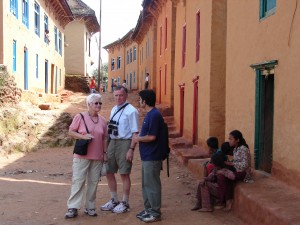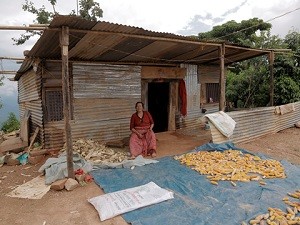This is what Palanchok village in Kavre used to look like (left). It was a quite well-off village too – and it remains the first ever village that we stayed in for a longer period of time. The earthquake changed everything for Palanchok and its people, like it did for thousands of other villages located in the “red zone” across the fourteen worst-affected districts. So, what’s next: how does a village like Palanchok move on?
Woman recovering tiles from the ruin for a makeshift shelter: scene from Palanchok.
We decided last year to follow Palanchok from the time of the earthquake and as frequently as time and money would allow in the years to come. Locals going through the rubble was the first scene that met the eyes when returning to Palanchok after the devastation on April 25, 2015. Most villagers were in a state of shock for weeks. Fortunately, the deathtoll was low – out of pure luck, since most people were outside their houses at the time – but not a single house was left intact. Most had crumbled in seconds, bricks and chunks of brown clay scattered all along the main street.
Palanchok has in a sense moved on but not to any permanent condition. Most locals now reside in temporary tin shelters that offer only ineffective protection from the elements whether it’s summer or winter. School has long-since started and many aspects of everyday life have indeed returned to normal. New obstacles should face them under the Indian blockade, from lack of cooking gas to high food prices and more! But at the heart of the tragedy still is – to many locals – the loss of their house and home. How will it ever be possible to rebuild all that?!The villagers of Palanchok in general are hopeful but not optimistic. Click here to read the latests about their efforts, their life, their hopes and disappointments in the post-quake reality which they share with so many other villagers today.
Follow the chronicle of Palanchok – one of thousands of villages – here…!
Like this page? Just click below to share:



